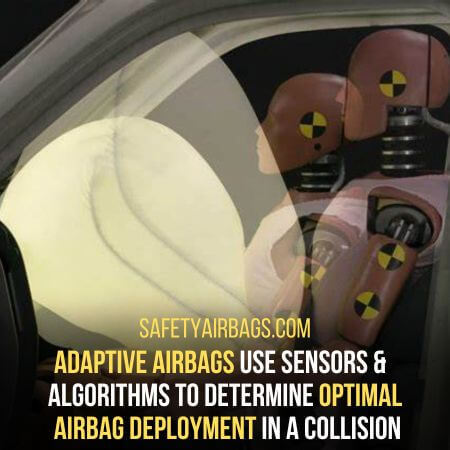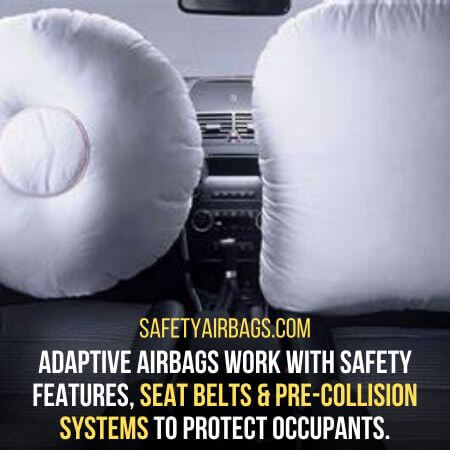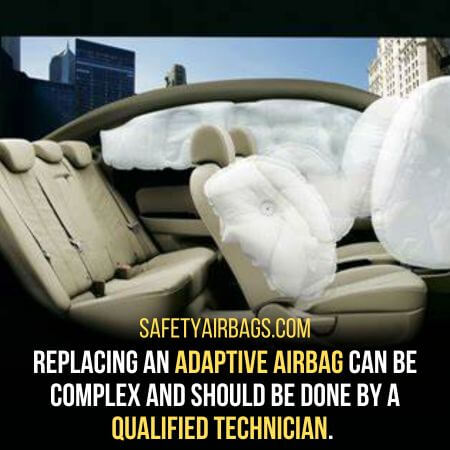Adaptive airbags are the latest advancement in vehicle safety technology. They are designed to provide a more personalized and effective protection system for occupants in the event of a collision.
What Will I learn
This article will explore adaptive airbags and their purpose in a vehicle. Moreover, their different types will help you decide which to get for your car safety.
Adaptive Airbags Working Mechanism
Adaptive airbags use sensors and algorithms to determine the optimal airbag deployment in the event of a collision. Thus they provide personalized and effective protection to occupants.
Here is their working mechanism in the form of steps:
1. Sensor Activation:
The sensors in an adaptive airbag system are designed to detect changes in the vehicle’s motion. This can indicate a collision.

Accelerometers, for example, measure changes in the vehicle’s acceleration. Gyroscopes detect changes in their orientation.
Other sensors may detect changes in vehicle speed, direction, and position.
To accurately determine the severity of a collision, the sensors must collect data from multiple points on the vehicle.
This allows the control module to analyze the data and determine the direction and force of the impact.
The sensors in an adaptive airbag system are typically located in the front of the vehicle. Here the majority of collisions occur.
However, some vehicles may also have sensors in other areas, such as the sides or rear of the vehicle.
2. Signal Processing:
The airbag control module is a small computer. It receives data from the sensors when a collision is detected.
The module then uses complex algorithms to analyze the data. That’s how it determines the appropriate deployment of the airbag.
The algorithms used in adaptive airbag systems take into account a wide range of factors, including:
– The speed and direction of the vehicle
– Angle of impact
– Weight and position of the occupants, and even
– Type of collision (such as a head-on collision or a side impact).
The control module also can adjust the airbag deployment based on the specific conditions of the collision.
For example, the collision is relatively minor. Therefore, the module may only deploy the airbag partially. But in more severe collisions, the airbag will be fully deployed.
3. Collision Severity Determination:
The control module uses the data collected from the sensors to assess the collision’s severity. This information is then used to determine the optimal deployment of the airbag.
The control module uses complex algorithms to analyze the data collected by the sensors. It takes into account factors such as:
– Vehicle’s speed
– Angle and direction of the impact
– Weight and position of the occupants.
The algorithms are designed to assess the collision’s severity. Then, they determine the appropriate deployment of the airbag.
For example, the airbag may only partially inflate in a low-speed collision. In contrast, the airbag will fully deploy in a high-speed collision to protect the occupants.
The collision severity determination stage is not a one-size-fits-all approach.
Instead, the control module assesses the data collected by the sensors to determine the most effective way to deploy the airbag.
It is based on the specific conditions of the collision. This personalized approach ensures that the airbag provides the best possible protection to the vehicle occupants.
4. Optimal Deployment:
The control module determines the exact timing and force needed for the airbag to provide the most effective protection to the occupants.
Then the control module uses the data collected by the sensors and the algorithms. Finally, it calculates the optimal deployment of the airbag.
This includes determining the deployment’s precise timing and the force needed to cushion the impact.
The goal of optimal deployment is to ensure that the airbag deploys at the right moment. Also, it must go off with the right force to provide the most effective protection to the occupants.
This may involve deploying the airbag in stages. The first stage is deploying at a lower force. The subsequent stages deploy at higher forces, depending on the collision’s severity.
5. Inflation:
Once the optimal deployment has been determined, the airbag inflates rapidly.
It combines chemical reactions and compressed gas to fill the airbag with gas. This process takes only a fraction of a second.
The gas used in the inflation process is typically nitrogen. It is inert and non-flammable, making it a safe option for use in a collision.
The chemical reaction to generate the gas typically involves the rapid decomposition of sodium azide. It produces nitrogen gas.
The inflation process is designed to provide a cushioning effect to the vehicle’s occupants. As a result, it reduces the impact of the collision and minimizes the risk of serious injury.
Comparison Of Adaptive Airbag With Traditional Airbags:
The main difference between adaptive and standard airbags is using sensors and algorithms. Standard airbags deploy with the same force regardless of the collision’s severity.
Adaptive airbags adjust their deployment to provide more personalized and effective protection.
This can include adjusting the force of the deployment, the deployment angle, and the airbag’s shape and size.
Overall, adaptive airbags provide more advanced and sophisticated protection to occupants during a collision.
Types Of Adaptive Airbags:
Adaptive airbags come in different types. Each is designed to provide optimal protection to vehicle occupants in specific collision scenarios.
The three main types of adaptive airbags are:
1. Smart Airbags:
Smart airbags use sensors to detect occupants’ size and weight. Then they adjust the airbag’s deployment accordingly.

For example, a child is sitting in the front seat. The airbag will deploy with less force to avoid causing injury to the child.
2. Multi-Stage Airbags:
Multi-stage airbags use sensors to determine the collision’s severity. Then, they adjust the airbag’s deployment accordingly.
As a result, they can deploy at different speeds and with different levels of force. This depends on the speed and direction of the impact.
3. Dual-Chamber Airbags:
Dual-chamber airbags use two separate chambers. As a result, they provide different levels of protection to the driver and the passenger.
In addition, the chambers are filled with different amounts of gas, depending on the size and weight of the occupants.
This allows the airbag to provide the most effective protection to each occupant, even if they are of different sizes or weights.
Comparison Of Each Type Of Adaptive Airbag:
Smart airbags protect occupants of different sizes and weights from injury. But they do not adjust to the collision’s severity.
Multi-stage airbags adjust to the severity of the collision. However, they do not adjust to the size and weight of the occupants.
Dual-chamber airbags provide the most personalized protection to the occupants. They adjust to both the occupants’ size and weight and the collision’s severity.
Therefore, dual-chamber airbags are considered the most effective in providing optimal protection to vehicle occupants.
Safety Benefits Of Adaptive Airbags:
Adaptive airbags have become a crucial component of modern vehicle safety systems. They offer several safety benefits, including:
1. Reduction In Fatalities And Injuries:
According to statistics, adaptive airbags have helped to reduce the number of fatalities and injuries in accidents.
For example, the National Highway Traffic Safety Administration (NHTSA) estimates that:
Between 1987 and 2017, airbags saved the lives of over 50,000 individuals in the United States alone.
Additionally, studies have shown that vehicles with adaptive airbags have significantly lower fatality rates than those without.
2. Prevention Of Head And Chest Injuries:
Adaptive airbags are most effective in preventing head and chest injuries, which are common in accidents.
Head injuries are often caused by the impact of the head on the steering wheel or dashboard. Chest injuries can result from the impact of the body on the seat belt.
Adaptive airbags deploy with the appropriate force and timing to protect the occupants’ heads and chests, reducing the risk of injury.
4. Provides Protection To All Occupants:
Adaptive airbags are designed to protect all vehicle occupants, regardless of their size or position.
Dual-chamber airbags, in particular, provide personalized protection to the occupants by adjusting to their size and weight.
This ensures that all occupants receive the most effective protection in the event of an accident.
Adaptive Airbags And Other Safety Systems:
Adaptive airbags work with other safety features, such as seat belts and pre-collision systems, to protect the vehicle’s occupants.
Seat belts keep the occupants securely in their seats during a collision. In a crash, the seat belt restrains the occupant’s body.
This prevents them from being thrown forward and making contact with the steering wheel, dashboard, or windshield.
The seat belt also helps to spread out the force of the collision across the strongest parts of the body. This reduces the risk of injury.
On the other hand, pre-collision systems detect an impending collision and prepare the airbags for deployment.

When the sensors detect an imminent collision, the system activates the airbags. Then, it adjusts its deployment force and timing to suit the nature of the collision.
This allows the airbags to deploy at the right moment and with the right force. This maximizes their Effectiveness in reducing injuries.
By working in unison, these safety features can significantly reduce the risk of injury or death in an accident.
Limitations And Concerns
Adaptive airbags provide significant safety benefits, but some limitations and concerns should be considered.
1. One limitation is that they may not effectively prevent injuries or fatalities in all collisions.
For example, adaptive airbags may not provide adequate protection in rollover accidents. Here the vehicle is subjected to multiple impacts from different angles.
2. Another limitation is that adaptive airbags rely on sensors to detect a collision. As a result, there may be situations where the sensors fail to detect a collision.
For instance, low-speed accidents or collisions where the point of impact is not directly in front of the vehicle.
3. Regarding concerns, there is a risk of injury from airbag deployments. That may be burns, abrasions, or fractures.
This is especially true in cases where the airbag deploys with excessive force. Or if the occupant is not properly positioned in the vehicle.
In addition, improper airbag installation or counterfeit or defective airbags can also pose a danger to vehicle occupants.
4. There is also a potential for accidental airbag deployment. It can occur if the airbag control module malfunctions or the vehicle experiences a sudden jolt or impact.
This can be particularly dangerous if the airbag deploys while the vehicle is in motion or if the occupant is not properly restrained.
Maintenance And Replacement
Regular maintenance and inspection of adaptive airbags are important for several reasons:
1. Ensure Proper Functioning:
Regular maintenance and inspection can help identify any potential issues with the airbags before they become a safety hazard.
This can help ensure that the airbags will function properly in a collision.
2. Increase Effectiveness:
Adaptive airbags are designed to work with other safety features. These may be seat belts and pre-collision systems.
Regular maintenance can help ensure all these safety features are working properly. It can increase the overall Effectiveness of the safety system.
3. Save Money:
Catching and addressing potential airbag issues early on can help prevent more significant and costly repairs.
It can also help prevent the need for more expensive replacements if the airbags fail to function properly during a collision.
4. Peace Of Mind:
Regular maintenance and inspection can give drivers peace of mind. They know that their vehicle’s safety features are working properly.

They know they are ready to protect themselves in a collision.
Recommended Replacement Interval:
The recommended replacement interval for adaptive airbags varies. It depends on the make and model of the vehicle.
However, most manufacturers recommend replacing the airbags after 10 to 15 years of use. It is regardless of whether or not the airbags have been deployed.
This is because the chemicals used in the airbag can deteriorate over time. This can cause the airbag to malfunction or not inflate properly in a collision.
It’s important to note that the replacement interval may be shorter in certain circumstances. For instance, if the vehicle has been in a collision and the airbags have been deployed.
In this case, the airbags will need to be replaced immediately. In addition, the rest of the vehicle’s safety system must be inspected for damage.
It’s also important to follow the manufacturer’s recommended replacement interval.
Using an airbag beyond its recommended lifespan can be dangerous. It may not provide the necessary protection in the event of a collision.
Process Of Replacing Airbag:
Replacing an adaptive airbag can be complex and should be done by a qualified technician.
Generally, the process involves removing the old airbag and installing a new one.
It may also involve replacing the airbag control module and any other components damaged in the collision.
Replacing an adaptive airbag can vary between $400-$1000. It depends on the make and model of the vehicle.
The type of airbag being replaced and the extent of the damage to the vehicle also determine it.
It’s important to note that the cost of replacing an adaptive airbag may not be covered by insurance. But that is if it is not deployed in a collision.
In addition, some manufacturers may require the replacement of other components. For instance, the airbag control module.
It is part of the replacement process, which can add to the overall cost.
Please ensure the airbag replacement process is carried out correctly and the vehicle is safe to drive.
It’s important to have the work done by a qualified technician familiar with the vehicle’s specific make and model.
Future Developments
Ongoing research and development efforts are focused on improving the performance and Effectiveness of adaptive airbag technology.
This includes the development of advanced sensors and software. They can detect the collision’s severity more accurately and adjust the airbag deployment accordingly.
Another emerging trend in airbag design is using new materials. For instance, carbon fiber or other lightweight materials.
They reduce the weight of the airbag while maintaining its strength and Effectiveness. This can help improve fuel efficiency and reduce the vehicle’s overall weight.
In addition, ongoing research is into using multiple airbags in a single vehicle. This includes airbags designed to protect against side-impact collisions or rollovers.
Conclusion:
In conclusion, adaptive airbags play a crucial role in promoting vehicle safety. They provide additional protection for drivers and passengers in a collision.
They have advanced sensor technology and can adjust deployment based on the collision’s severity.
As a result, adaptive airbags are highly effective in reducing the risk of serious injuries and fatalities.
However, there are some limitations and concerns associated with adaptive airbags.
For example, there is the risk of injury from airbag deployment or the danger of counterfeit or defective airbags.
These risks can be mitigated through regular maintenance and inspection. Moreover, the use of high-quality, genuine airbag components is necessary.
Ongoing research and development efforts continue to improve the performance and Effectiveness of adaptive airbag technology.
We can expect to see even greater advancements in vehicle safety in the years to come.
Overall, adaptive airbags are an essential component of modern vehicle safety systems. Moreover, they are an important tool in protecting drivers and passengers on the road.
